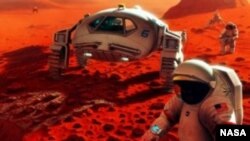The U.S. space agency is relying on findings from an ongoing, unmanned mission to Mars as it shapes plans for a human mission to that planet in the mid-2030s.
As NASA's Mars Science Laboratory sped toward the Red Planet in 2011 and 2012, an instrument called the Radiation Assessment Detector measured radiation levels that a space crew could experience during the long journey.
New findings published in the journal Science indicate a trip to Mars could subject space travelers to more radiation than NASA allows. Longstanding research shows that exposure to radiation increases a person's risk of developing cancer.
Propulsion
Scientists say one way to reduce radiation exposure is to develop new propulsion technologies that would shorten the time it takes to get to Mars, thereby reducing the time a person is subjected to radiation in deep space.
NASA's deputy director of advanced exploration systems, Chris Moore, says engineers are working on advanced systems that could cut a one-way trip to Mars down from about 250 days to 180 days.
"To get really fast trip times and cut down on the radiation exposure, we would probably need nuclear thermal propulsion, and we're working with the U.S. Department of Energy now to look at various types of fuel elements for these rockets," said Moore. "But it's a long-range technology development activity, and it will probably be many years before that is ready."
Moore emphasized that nuclear thermal propulsion is part of the current plan to get humans to Mars.
Shielding
During the journey through deep space, astronauts would be exposed to two types of radiation that pose potential risks. Galactic cosmic rays are caused by supernova explosions and other high-energy events outside the solar system. Solar energetic particles are linked to solar flares and coronal mass ejections from the sun.
Eddie Semones, the space flight radiation health officer at NASA's Johnson Space Center in Houston, says this requires a two-pronged mitigation approach.
"We need to get there [to Mars] faster to reduce the impact of the galactic cosmic rays, but we need to have shielding, local shielding, on board to eliminate the effects of solar particle events, so it's hand-in-hand," he said.
Semones says deployable shields are effective at reducing the effects of solar particle events because those events are low energy. But he says in order to reduce the effect of high-energy galactic cosmic rays, shields would have to be meters thick -- too thick for a spacecraft to launch successfully from Earth.
Looking to the Future
The Curiosity rover's Radiation Assessment Detector continued to take measurements after it landed on the Martian surface in August.
NASA says the medical community is using the radiation data to develop exposure limits for deep space explorers.
As NASA's Mars Science Laboratory sped toward the Red Planet in 2011 and 2012, an instrument called the Radiation Assessment Detector measured radiation levels that a space crew could experience during the long journey.
New findings published in the journal Science indicate a trip to Mars could subject space travelers to more radiation than NASA allows. Longstanding research shows that exposure to radiation increases a person's risk of developing cancer.
Propulsion
Scientists say one way to reduce radiation exposure is to develop new propulsion technologies that would shorten the time it takes to get to Mars, thereby reducing the time a person is subjected to radiation in deep space.
NASA's deputy director of advanced exploration systems, Chris Moore, says engineers are working on advanced systems that could cut a one-way trip to Mars down from about 250 days to 180 days.
"To get really fast trip times and cut down on the radiation exposure, we would probably need nuclear thermal propulsion, and we're working with the U.S. Department of Energy now to look at various types of fuel elements for these rockets," said Moore. "But it's a long-range technology development activity, and it will probably be many years before that is ready."
Moore emphasized that nuclear thermal propulsion is part of the current plan to get humans to Mars.
Shielding
During the journey through deep space, astronauts would be exposed to two types of radiation that pose potential risks. Galactic cosmic rays are caused by supernova explosions and other high-energy events outside the solar system. Solar energetic particles are linked to solar flares and coronal mass ejections from the sun.
Eddie Semones, the space flight radiation health officer at NASA's Johnson Space Center in Houston, says this requires a two-pronged mitigation approach.
"We need to get there [to Mars] faster to reduce the impact of the galactic cosmic rays, but we need to have shielding, local shielding, on board to eliminate the effects of solar particle events, so it's hand-in-hand," he said.
Semones says deployable shields are effective at reducing the effects of solar particle events because those events are low energy. But he says in order to reduce the effect of high-energy galactic cosmic rays, shields would have to be meters thick -- too thick for a spacecraft to launch successfully from Earth.
Looking to the Future
The Curiosity rover's Radiation Assessment Detector continued to take measurements after it landed on the Martian surface in August.
NASA says the medical community is using the radiation data to develop exposure limits for deep space explorers.






